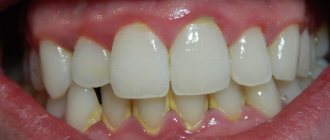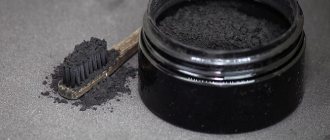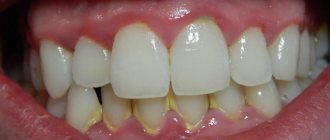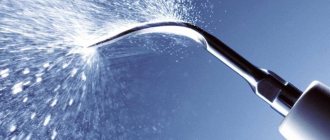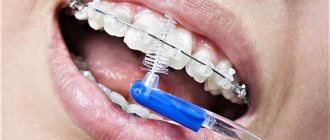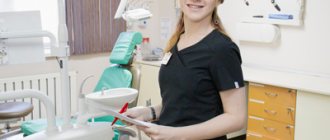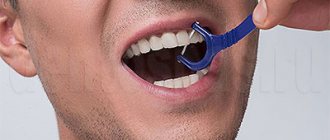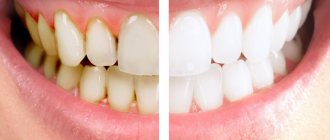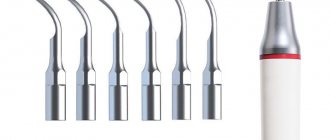Dental calculus is one of the most common pathologies. According to statistics, more than 65% of adults have it. Tartar should not be treated only as an aesthetic defect.
In addition to causing bad breath, tartar is the cause of many dental diseases and promotes infection in the body. Therefore, it is necessary to prevent stone formation, and if it forms, immediate treatment by a dentist.
What is tartar
Tartar is a hard, calcareous deposit on the surface of the tooth that is yellowish to dark brown in color. Initial plaque consists of food debris, dead cells, mucus and microorganisms. The stone is formed when soft plaque accumulates and thickens, and its gradual mineralization with calcium, phosphorus and iron salts. First, it forms in places where plaque accumulates the most: in the gingival zones, in the tooth sockets and in the interdental space. Most often on the inside of the dentition, where there is a hard-to-reach area for brushing teeth and the exit of the salivary gland canals. As the process progresses, it can cover the entire visible surface of the tooth and go under the gums.
Main stages of ultrasonic processing
The dentist conducts an examination, identifies places where tartar accumulates, the amount, and determines its density in order to choose the appropriate cleaning regimen. Sometimes teeth are treated with a special solution that reveals the boundaries of plaque. If the patient has sensitive teeth, gums or deep subgingival calculus, anesthesia (injection or application) is performed.
Stone removal is carried out in three stages:
Brushing teeth with a skyler
Skyler is a dental instrument that generates ultrasonic air vibrations. Water (an antiseptic solution) mixed with air is sprayed through a narrow nozzle. The liquid is intended to cool the tooth and wash away the separated plaque.
The ultrasonic wave forms cavities in mineralized deposits, the plaque cracks and peels off from the enamel. The fragments are removed with a saliva ejector.
First, the doctor cleans the crowns, then the subgingival area, guiding the scaler with parallel vertical movements.
Brushing teeth with a skyler
Polishing
Cleaned teeth have a rough surface. To slow down the adhesion of food and bacteria, polishing is used.
Main types:
- Mechanical with special paste and a round elastic brush. The interdental spaces are polished with thin strips or narrow spiral-shaped brushes.
- Hardware using the AirFlow method - using a powerful jet of water with an abrasive containing sodium bicarbonate.
Brushing your teeth with a special paste and a round brush
Fluoridation
Fluoridation helps strengthen enamel and reduce hyperesthesia (sensitivity) in the cervical area.
- The tooth surface is dried with a stream of warm air for better adhesion.
- Apply a composition containing fluoride ions (gel or varnish) and dry again.
- The teeth are treated with a swab soaked in copper hydroxide and calcium solution. The substances enter into a chemical reaction, and calcium fluoride crystals are formed in the dentinal tubules and other irregularities, which strengthen the tooth tissue and prevent infection.
How quickly does a stone form?
The rate of stone formation varies from person to person and depends on hygiene skills and factors contributing to stone formation. In the absence of brushing your teeth, within a few hours after eating, a thick film of a huge number of bacteria feasting and multiplying on food debris forms on the surface of the tooth. After a week, the film thickens due to mineralization processes. On average, it takes about 4–6 months to form a dense stone. Therefore, a preventive examination by a dentist is necessary at least once every six months.
How to soothe an aching tooth?
If aching pain inside a tooth or after the removal of a wisdom tooth prevents you from sleeping peacefully or generally thinking about anything else, you need to take care to reduce it to a minimum. And at the first opportunity, be sure to consult a dentist, because pain relief does not mean that the problem has been eliminated, and there is no need for treatment. You can eliminate pain as follows:
- First of all, thoroughly brush your teeth and remove any remaining food from the interdental spaces.
- Rinse your mouth with a soda-salt solution (a teaspoon of soda and salt per glass of warm boiled water). You can use only saline solution or just warm water if nothing else is available.
- Take a pain reliever (analgin, paracetamol, ibuprofen) if possible.
- If there are no medications at hand, you can relieve pain with folk remedies. Rinsing with decoctions of chamomile, calendula, sage, and calamus root helps to cope well with toothache. You can also use tampons soaked in clove, sea buckthorn or mint oil, which should be applied to the affected area. Rinsing with alcohol-containing liquids - propolis tincture, regular vodka or cognac (sweetened alcohol-containing drinks cannot be used for this purpose!) can help get rid of pain.
It is strictly not recommended to use warming procedures in this case - rinsing should be at approximately room temperature, warm compresses and heating pads should not be applied to the sore area. Heat only accelerates and intensifies the inflammatory process, which can provoke the rapid development of a purulent abscess and the spread of inflammation to nearby tissues.
Symptoms
Signs of tartar:
- using a mirror you can see dark deposits on the teeth near the gums (mostly on the inside), which do not disappear after hygiene procedures;
- darkening of tooth enamel;
- constant bad breath;
- bleeding gums when brushing teeth;
- increased gum sensitivity;
- deepening and widening of gum pockets, exposure of tooth roots.
Only supragingival plaques can be seen visually; subgingival formations are diagnosed by a doctor.
Why is tooth stone dangerous?
In addition to an aesthetic defect, tartar is a common cause of a repulsive putrid odor from the mouth. In addition, stone formation can provoke the development of severe dental diseases:
- caries;
- gingivitis;
- periodontitis;
- tooth loss.
The presence of stone deposits reduces the local immunity of the oral cavity, which increases the proliferation of bacteria and aggravates the manifestation of their pathogenic properties. The consequence of the activity of bacteria is the destruction of tooth enamel and the development of various inflammatory processes in the oropharynx. Subgingival stones destroy the connection between teeth and bone, causing them to loosen and fall out. With severely advanced processes, it is no longer possible to stop tooth loss.
Is it painful to remove subgingival calculus?
When cleaning stone in subgingival pockets, in most cases, mild pain occurs. This is explained by the fact that the stone is attached directly to the periodontium. Even a thin layer of enamel significantly reduces tooth sensitivity; it simply does not exist in the subgingival zone. Therefore, discomfort during the procedure is a completely reliable and expected phenomenon.
Subgingival stone must be removed, as it causes the development of putrefactive bacteria and contributes to the occurrence of caries and inflammatory diseases of the oral cavity.
Causes of tartar
The formation of tartar is a consequence of:
- insufficient or improper oral hygiene;
- disorders of mineral metabolism in the body, which is often associated with the presence of chronic diseases or genetic predisposition.
Factors that contribute to the formation of tartar, subject to insufficient hygiene, include:
- defective position of teeth;
- roughness of the tooth surface, often due to the installation of low-quality filling material or insufficient polishing;
- presence of braces and dentures.
- preference in the diet for soft and carbohydrate foods;
- one-sided chewing;
- smoking;
- alcohol abuse;
- hypersalivation (secretion of large amounts of saliva);
- a general decrease in the body’s immunity and the presence of foci of chronic infection.
Smokers' tartar
There are practically no heavy smokers who do not have tartar. Tar from tobacco smoke and soot deposit a yellow coating on tooth enamel. It is easier for food debris to stick to this plaque and for bacteria to multiply comfortably. Gradually, under the influence of both saliva and tobacco smoke, various salts are deposited in plaque and brown tartar is formed. In addition, tobacco smoke contains toxic substances and heavy metals, which trigger the process of detachment of the gingival margin from the teeth. Food is stuffed into the deep gaps and optimal conditions are created for the growth of colonies of pathogenic bacteria. A regular toothbrush does not sweep out pathological contents from such pockets. And bacteria eat away the connective tissue between teeth and bone, exposing their roots. A dangerous inflammatory disease – periodontitis – gradually develops. Tartar deposited under the gum does not give a chance for self-healing, but turns the disease into a chronic form. Combined with the effects of tartar and destruction of the connective tissue that anchors the teeth, the process of development of periodontitis in smokers proceeds 3 times faster than in non-smokers. This leads to rapid tooth loss. According to statistics, 80-year-old smokers have 2.5 times fewer teeth than non-smokers.
Prevention of stone deposits
Prevention of any disease is always cheaper than its treatment. This applies not only to the financial component, but also to the temporary and psychological component.
The most important thing in preventing dental diseases is proper oral hygiene.
How to brush your teeth
To prevent the formation of tartar, learn how to brush your teeth correctly:
- Movements when brushing your teeth should be “sweeping”, in the direction from the gums to the edge of the tooth.
- First brush your front teeth, then carefully treat the inner surface of the dentition.
- The chewing surface is cleaned with back-and-forth and circular movements. Don't forget about your wisdom teeth.
- The duration of cleaning should be at least 3 minutes. To do this, it is convenient to have an hourglass in the bathroom or to clean while listening to a certain musical composition.
- Brush your teeth at least twice a day. The first time is after breakfast, the second time after dinner. If you are prone to the formation of stones, brush your teeth additionally after each meal.
Choosing a toothbrush
Not everyone knows how important it is to choose the right brush. Listen to the experts:
- Choose a high-quality, medium-hard toothbrush, preferably with rubber blades, which increase the effectiveness of removing plaque and polishing teeth.
- Soft brushes are only suitable for children or during periods of bleeding and sore gums.
- Hard brushes can be used 1 or 2 times a week. They should not be used in places where the necks of the teeth are exposed, especially if the sawing cleaning is improper. This contributes to the formation of wedge-shaped defects.
- Don't forget to change your brush every month.
Interesting experiment!
American doctors conducted an experiment, the participants of which were divided into 5 groups.
The first group: brushed their teeth with regular brushes and expensive toothpaste for 1 minute.
Second group: brushed their teeth with regular brushes and expensive toothpaste for 5 minutes.
Third group: they brushed their teeth with regular brushes and cheap toothpaste for 5 minutes.
Fourth group: they tried to brush their teeth without a brush, by rubbing expensive toothpaste with their fingers.
Fifth group: brushed their teeth with regular brushes without toothpaste, but for at least 5 minutes.
The experiment lasted a week. Every day after the procedure, the cleanliness of the teeth was measured.
At the end of the week there were the following results (the more stars, the cleaner the teeth):
| Group number | Brushes | Paste | Cleaning time | Result |
| 1 | Regular | Expensive | 1 minutes | Bad result |
| 2 | Regular | Expensive | 5 minutes | Excellent result |
| 3 | Regular | Cheap | 5 minutes | Excellent result |
| 4 | Without brushes | Expensive | 5 minutes | No result |
| 5 | Regular | Without paste | 5 minutes | Good result |
Conclusion: it turned out that when brushing your teeth, the toothbrush and the time spent on the procedure are important. You can brush your teeth even without toothpaste; it will be much more effective than using toothpaste without a brush. And if you clean it correctly, there is almost no difference between expensive or cheap toothpaste.
Other hygiene rules
- For continuous use, use only therapeutic and prophylactic pastes from well-known companies. For people prone to the formation of stones, it is useful to periodically brush their teeth with abrasive whitening pastes, for example, 2 times a week.
- After each meal, thoroughly rinse your mouth with special elixirs, and if you don’t have them on hand, you can use plain water.
- Use floss (special thread) to remove plaque between teeth. Floss is used both after brushing your teeth and without it in the afternoon. However, do not make cutting movements (back and forth), so as not to damage the gums, the movements should be: up and down.
- After brushing your teeth, use special devices - irrigators, which, under the pressure of a stream of water, will clean all places that are difficult for a brush to reach from bacteria and food, and improve blood circulation in the gums and dental pulp. In addition, you can polish your teeth with a special irrigator attachment, then it will be more difficult for the stone to be deposited on smooth enamel. Today, irrigators are recognized by dentists as one of the most effective ways to prevent tartar.
- Quit smoking completely. Or, at worst, use electronic cigarettes, the vapor of which does not contain toxic substances and resins involved in the formation of stones.
- Get a preventive examination from your dentist at least once a year, and more often if indicated.
- Have your teeth professionally cleaned periodically.
Will my teeth hurt after the procedure?
Your teeth will not hurt after brushing the stone. On the contrary, the resulting feeling of freshness in the mouth contributes to an overall comfortable feeling. Your doctor may recommend using mouthwash for a while after cleansing.
Important. After the procedure, it is recommended not to eat or smoke for a couple of hours.
Do not ignore preventive visits to the dentist.
It is enough to visit a specialist 1 – 2 times a year, which will allow you to promptly identify any dental problem at an early stage of development. This means that its elimination will be quick, easy and without complications.
By clicking the “request a call” button you agree to the personal data processing policy.
Ultrasonic toothbrushes
Recently, a new gadget has appeared on the market - an ultrasonic toothbrush. In addition to mechanical cleaning, this brush provides ultrasonic treatment of hard-to-reach areas of the tooth and gums to a depth of up to 4 mm. Ultrasonic waves destroy bacteria and effectively remove pigmentation and deposits when mineralization begins. However, such a brush cannot remove formed tartar; this can only be done by a specialist using professional equipment. In addition, the use of an ultrasonic brush is effective and safe only for people with absolutely healthy teeth.
Plaque on a child’s teeth: treatment
Removing bacterial and chromogenic plaque in a child will be no different from a similar procedure recommended for an adult: ultrasonic cleaning and AirFlow are used in the same way.
However, chromogenic staining of teeth may return over time. The only possible solution to the problem is regular professional cleaning by a dentist. To make visits to the dentist as rare as possible, your child should be taught to use an electric toothbrush, the pulsating circular movements of the head of which perfectly break up plaque.
Accelerated formation of deposits is promoted by blood in the oral cavity, so the child’s gingivitis must be treated. The use of chlorhexidine and antiseptics based on it should be abandoned.
Contraindications to ultrasonic brushes
Due to the presence of ultrasonic microvibration, the use of such brushes is not recommended for persons:
- with veneers, fillings and crowns, as their service life is reduced;
- with areas of loose and porous enamel, due to the fact that the development of the carious process accelerates due to the destruction of defective enamel;
- with gingivitis and periodontitis, due to the increased spread of infection by hematogenous route;
- with periodontal disease, as the process of bone destruction accelerates;
- having precancerous changes and cancer, due to the acceleration of the division of atypical cells.
These significant drawbacks significantly limit the use of ultrasonic brushes, since almost 95% of the adult population have certain problems. It is also not recommended to use any power brushes during pregnancy or for people with pacemakers.
White caries - black caries, time plays against teeth
The enamel is translucent and normally ranges in color from light yellow to grayish-white. The color of dentin and any material underneath the enamel greatly affects the appearance of the tooth. Surprisingly, caries begins in the form of the formation of a barely noticeable white matte spot on the enamel (Fig. 6) [3].
Figure 6. “Dental problems.” Over time, the white spots on the enamel caused by caries darken.
drawing by Anastasia Prokhorova
Further, such a stain darkens from frequent meals: the area of the tooth softens more and more, and in the lucky ones a painless hole is formed - a carious cavity [7]. For some unfortunate people, caries is accompanied by inflammation of the tissues around the tooth, infection, and sometimes even an abscess, which can lead not to the small aesthetic problem of “black spots”, but to the loss of the tooth itself.
Hardware ultrasonic cleaning.
This is the most popular and effective way to remove mineral deposits. Ultrasonic waves break up tartar and easily remove it from the enamel surface. Moreover, such cleaning has an antiseptic effect and is therefore also indicated for gum inflammation. If the stone formation is very dense, before the cleaning procedure, means are used to soften it, then ultrasonic removal of deposits is carried out. During ultrasonic cleaning in the area of the neck of the lower incisors, when the roots are exposed, there may be mild pain. Then, at the request of the patient, local anesthesia is applied.
Despite the presence of many contraindications for the use of ultrasonic toothbrushes, the use of ultrasonic cleaning when removing stone is necessary. First, the dentist will use visual guidance to avoid areas of thinned, porous enamel. Secondly, one-time professional cleaning does not have as negative an effect on fillings as twice-daily brushing.
Laser cleaning.
The newest non-contact method of removing hard dental deposits is highly effective and absolutely painless. However, the price is much more expensive than ultrasonic. Laser cleaning has the same contraindications as ultrasonic cleaning.
Air-flow
Refers to mechanical methods. A jet of air with a therapeutic abrasive mixture is supplied under pressure, which removes both soft plaque and hard deposits. The gum area may tingle during the procedure. It is less effective than ultrasonic and laser cleaning.
Manual method
Mechanical manual method of beating stones using special tools. Currently, it is outdated due to the painfulness of the procedure, the presence of complications and the emergence of more effective methods. It is used free of charge under the compulsory medical insurance policy in public hospitals or as an additional method of treatment if indicated. Due to the painfulness of the procedure, especially when removing subgingival stones, local anesthesia is performed. It is a relative contraindication for periodontitis due to high trauma.
Is ultrasonic teeth cleaning harmful?
Ultrasonic cleaning does not pose any threat to teeth and the body as a whole. An exception is situations in which the technology is broken or the patient has contraindications. Ultrasound can damage enamel if it is thinned or has such a structural feature. Sometimes brushing causes bleeding from the gums. The doctor will help stop it and advise what needs to be done for speedy healing.
Advice: to avoid possible troubles, before starting the procedure, the dentist finds out the state of health, concomitant diseases, and reaction to medications. Answer honestly and directly, every nuance matters.
After the procedure
At the end of the procedure, regardless of the method of stone removal, the dentist must grind and thoroughly polish the enamel.
Sometimes, at the request of the patient, after cleaning, the teeth are coated with a special protective composition against infection and plaque buildup.
Within 15 days after cleaning:
- Do not use bleaching abrasive pastes;
- the use of toothpastes from the “sensitive” series, based on herbs and with an anti-inflammatory effect, is indicated;
- rinses with astringent and soothing properties are recommended;
- Do not eat spicy foods or dyes;
- categorically give up smoking or at least abstain for this period.
Are there any traditional methods for removing stones?
There are no home methods to remove stones in one procedure, like in clinics. Moreover, with extensive and long-fossilized formations, traditional methods will not help. Grandmother's recipes can only be used when stone formation begins, when the deposits are thick, but still loose and light. In this case, the following will help:
- cleansing teeth with radish pieces;
- It is also useful to eat a salad of grated radish with lemon every day;
- brush your teeth with fresh and already cooled coal ash;
- soften plaque with hydrogen peroxide, then brush your teeth with soda.
It should be noted that the first two methods will definitely not cause harm; they can be safely used, even if they do not help. But the last two options do not have clinical trials and proven effectiveness, and therefore may be unsafe. Therefore, you should not take such dubious and radical measures on your own when dental care is available to everyone.
Competition “Bio/Mol/Text”-2020/2021
This work was published in the “Free Topic” category of the “Bio/Mol/Text” competition 2020/2021.
The general partner of the competition is the annual biotechnology conference BiotechClub, organized by the international innovative biotechnology company BIOCAD.
The sponsor of the competition is SkyGen: a leading distributor of life science products on the Russian market.
Competition sponsor: the largest supplier of equipment, reagents and consumables for biological research and production.
"Book" sponsor of the competition - "Alpina Non-Fiction"
We would all like to have brilliant, healthy white teeth so that we can proudly show them off to others, and those around us would immediately fall into delight from such a demonstration. But, alas and ah, the problem of caries lies in wait for our teeth literally around every corner. However, if you are “armed and dangerous”, namely, you know where the roots of caries come from, that’s already half the victory! Therefore, let's understand the biological subtleties of its occurrence.
Contraindications
Contraindications for hardware teeth cleaning include:
- wearing dentures and braces;
- the presence of implants in the body, including pacemakers;
- ARVI, active stage of tuberculosis, HIV infection;
- oncological diseases;
- pregnancy (or with the permission of an obstetrician-gynecologist);
- childhood, until all baby teeth are replaced.
- pregnancy.
Pregnancy is a relative contraindication to dental cleaning. Dental procedures can be performed during a satisfactory pregnancy with the permission of an obstetrician-gynecologist. If there is a threat of miscarriage or other serious conditions, it will be recommended to postpone the removal of stone deposits and the beauty of the smile.
Is it possible to reverse tooth decay?
If you have already noticed the first stages of enamel destruction, then caries cannot be reversed, but it can be slowed down, stretching the process over decades. Ion exchange reactions always occur on the surface of the enamel, allowing one to maintain a delicate balance between demineralization (destruction) and remineralization (restoration) of the enamel. Calcium and magnesium ions, phosphate ions, carbonate ions, strontium and fluorine ions can penetrate into the hydroxyapatite crystal. Of all the listed ions, we are especially interested in the fluorine ion F⁻ . Fluorine can replace the hydroxyl group (OH⁻) of enamel hydroxyapatite, forming fluorapatite Ca₅(PO₄)₃F . Fluorapatite is more resistant to acids, so the vital activity of bacteria has little effect on it [6].
In the article “Tooth Strength: How Do Pastes Make Our Teeth Better?” [10] of the special project “Biology, Medicine and Cosmetology of the Oral Cavity” talks in detail about fluoride and other useful components of toothpastes. - Ed.
Fluoride therapy is used to prevent tooth decay. The most pronounced effect is observed with optimal intake of fluoride ions into the body during the development of primary and molar teeth, that is, in childhood, but also in the first stages of caries - in the white spot stage - such therapy can slow down its course [6], [8] . Eating a balanced diet will also help keep tooth decay at bay. Cereals (bran, whole grain flour, sprouted grains), vegetables and fruits, spices (parsley, cumin, spinach), as well as animal products (fish, meat, especially bone broth, liver, seafood) contain large amounts of fluoride.
Well, if caries is already noticeable with might and main, then radical measures will be required to eliminate it in the dentist’s chair. By the way, the filling material also contains fluorapatite.
Take care of your teeth!
This short review article has already been published by the author here: https://vk.com/@biovk-temnye-delishki-nashih-zubov-karies.
